Everything you need to Know about the operation of the heat pump.
The Heat Pump is very simple once you understand the basic concept (and I promise you will after reading this). As the name suggests a heat-pump transfers or pumps heat from one place to another, (notice the use of the word “pump”- heat is not generated but rather is moved).
As they say “a picture worth a thousand words”. So let’s see one:
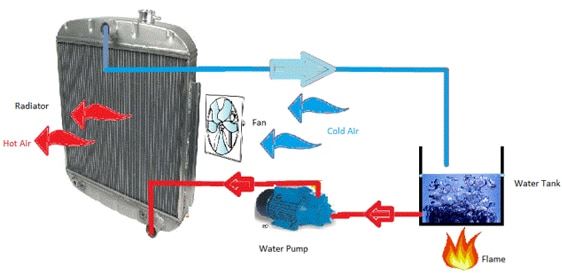
In this Example:
- The flame heats up the water.
- The hot water is pumped to the radiator.
- The fan forces the Cold Air over the Hot Radiator and the air becomes hot.
- The water becomes cold because the heat has been transferred from the water to the air. The cold water is then pumped back to water tank- where it is heated up again (Step 1).
- Notice in this example that the flame generates the heat. We transfer that heat to the air using a medium (in this case the water) pumped through a radiator. Pumped heat- a heat pump!
- The real heat pump doesn’t differ that much from this simple example- we just replace the water with a refrigerant (such as Freon) and replace the water pump with a compressor.
The real Heat Pump in action
Cooling Mode (regular Air Conditioning)
Hold on a minute- Does that mean a regular air conditioner is considered to be a heat pump?
Well let’s see:
- Heat is generated inside your house- from sun shining through windows and onto the roof and walls, from appliances and from your body. This is the equivalent of the flame heating the water in our first example.
- Your air conditioner transfers that heat from inside your house to outside your house. This is the equivalent of the pump and radiator
So in theory- yes, any regular air conditioner can be considered to be a heat pump (but don’t tell this to your repair man or you will confuse him!)
So what is different between your regular air conditioner and a heat pump?
Before we discuss the difference let’s see how the heat pump acts in Cooling Mode:
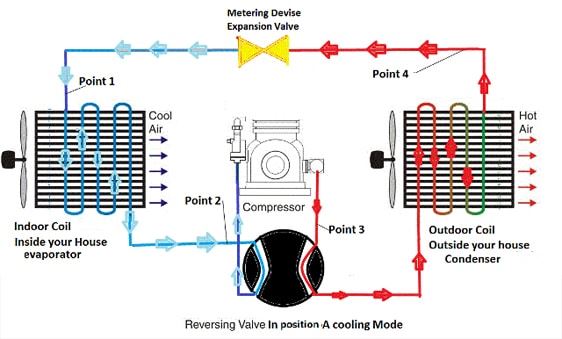
Before we start notice three things:
- The position of the Reversing Valve
- The Direction of the flow of the refrigerant.
- The inlet and outlet ports of the Compressor (those will never change) Did you notice?
OK- Let’s continue and we’ll start at Point 1 on the diagram:
- Point 1 – At the beginning of the cycle the refrigerant (such as Freon) is in a liquid form (gas contained under pressure becomes a liquid just like the propane in the tank that you use to BBQ that juicy steak). This liquid refrigerant is very cold. It enters the evaporator coil located inside your house. The hot air in your house moves over the coil and the air starts to lose its heat and cool down.
- Point 2 – After the refrigerant leaves the indoor evaporator coil it has absorbed heat and become gas. Just like when you heat water on the stove and it becomes steam the refrigerant gas evaporated when it absorbed all that heat in the house (that’s why we call this coil the evaporator).The refrigerant enters the compressor which mechanically pressurizes the gas. That process will increase its temperature so the refrigerant will leave the compressor as hot gas.
- Point 3 – The refrigerant next moves to the condenser coil located outside the house. Because the temperature outside is lower than the temperature of the hot gas the heat is transferred or “rejected” from the refrigerant in the coil to the outside air. As the temperature of the refrigerant gas cools it will form liquid condensate- just like the water droplets that form on a cold glass of soda (that’s why we call this coil the condenser).
- Point 4 – The refrigerant leaves the outdoor condenser coil as warm liquid. Now we need to make the warm liquid refrigerant cold so that it can absorb more heat. So it goes to the metering device which drops the pressure on the warm liquid and thus drops its temperature. The refrigerant leaves the metering device as a cold liquid, ready to repeat the cycle again.
Now what about heating- how does that work?
Well let’s look at the next diagram:
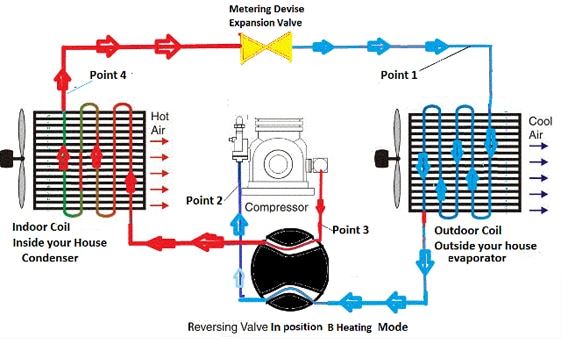
Did you notice what just happens?
Here are the two diagrams, side by side. Look carefully this time:
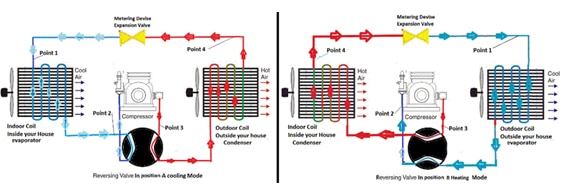
Look at the reversing valve it Rotates 90o , that changes the direction of the flow of the refrigerant (Freon). It goes in the opposite direction and this is the reverse of the cooling cycle. Instead of absorbing heat from inside the house it absorbs heat from the air outside the house and “rejects” (or transfers) that heat to the indoor air. Now the indoor coil has become Condenser and the outdoor coil has become Evaporator.
Notice that the heat isn’t generated by an oil burner or a gas furnace. It is just moved (or pumped) from the outside air to inside the house. This is why the Heat Pump is so popular in moderate climates. You don’t need to have a furnace or get oil or gas delivered when the weather cools off. Because of the reversing valve you can use the same electric system as both an air conditioner and a heater!
Let’s summarize things up:
- Heat pumps (or air conditioners) don’t generate heat. The heat already exists inside your home.
- It is exactly like an air conditioner- it moves the heat from one place to another.
- The only different is that in heat pumps we have a Reversing Valve that allows us to choose to move the heat from inside the house to the outdoors (cooling mode) or to reverse the cycle and remove the heat from outside the house to the indoors (heating mode).
- Air conditioners don’t have a Reversing Valve so they can only move the heat from inside the house to the outdoors (cooling mode only).
- One more thing the heat pump thermostat is completely different than a regular thermostat. So make sure that you are using the right one.
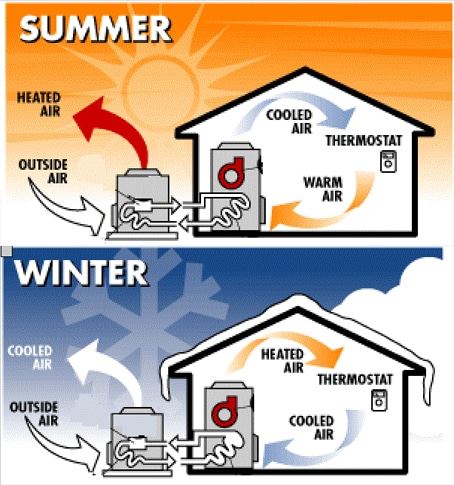
How heat pumps function in both summer and the winter.
Contact us today at 616-396-HEAT (4328) or on Facebook!
The post How Do Heat Pumps Work? appeared first on Baumann & DeGroot Heating & Cooling.

